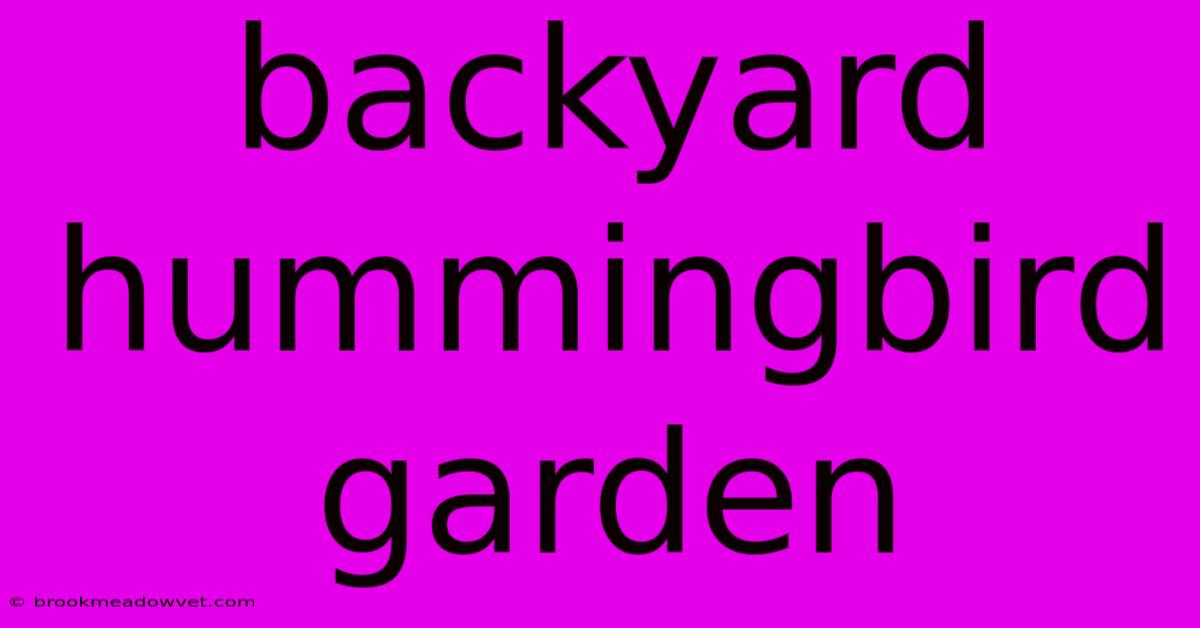Backyard Hummingbird Garden

Table of Contents
Attract Hummingbirds to Your Backyard with a Vibrant Garden
Hummingbirds are dazzling little creatures, known for their vibrant colors, buzzing wings, and incredible energy. Their presence in your backyard can bring a touch of magic and joy. Creating a hummingbird-friendly garden is a rewarding endeavor that requires understanding their needs and preferences. Here's a comprehensive guide to attracting these feathery jewels to your outdoor sanctuary:
The Essentials for a Hummingbird Haven
1. Provide a Feast of Nectar:
- Hummingbird feeders: These are essential for supplementing natural nectar sources, especially during lean times. Choose feeders with red accents to attract hummingbirds, and keep them clean to prevent the growth of harmful bacteria.
- Nectar recipe: A simple and effective nectar solution can be made by mixing one part granulated white sugar with four parts water. Boil the mixture for a few minutes to dissolve the sugar and prevent spoilage. Let it cool completely before filling your feeders.
2. Plant a Buffet of Colorful Blooms:
Hummingbirds are attracted to vibrant flowers with long, tubular shapes that allow them easy access to nectar. Choose from a variety of flowering plants that bloom throughout the season, ensuring a constant food source:
- Annuals: Salvia, petunias, zinnias, bee balm, geraniums, and nasturtiums.
- Perennials: Lupine, foxglove, cardinal flower, trumpet vine, and honeysuckle.
- Shrubs: Butterfly bush, rhododendron, azalea, and hibiscus.
3. Offer Perches and Shelter:
Hummingbirds need safe places to rest and perch between feeding sessions. Consider:
- Small branches: Include branches of varying heights and thicknesses in your garden for easy access and perching.
- Small trees: Native trees with dense foliage provide both shade and refuge from predators.
- Water sources: Hummingbirds enjoy bathing in shallow water sources like birdbaths or dripping fountains.
Creating an Inviting Hummingbird Habitat
1. Location is Key:
- Sunlight: Choose a sunny spot in your backyard for your hummingbird garden, as flowers need ample sunlight to thrive.
- Protection: Place feeders and plants in a location that offers some protection from wind and harsh weather.
- Visibility: Ensure your garden is visible to hummingbirds from different angles to encourage exploration.
2. Color Palette:
- Red is the Favorite: Red is the most attractive color to hummingbirds, so incorporate red flowers, feeders, or ornaments in your garden.
- Variety is Key: Offer a diverse range of colors to attract various hummingbird species.
3. Natural Companions:
- Butterfly plants: Butterflies are often associated with hummingbirds and create a more lively atmosphere in your garden.
- Other pollinators: Attract bees, wasps, and other pollinators to create a vibrant and healthy ecosystem.
Enjoy the Show!
Once you've created a hummingbird-friendly garden, sit back and enjoy the spectacle. These tiny birds are a wonder to watch as they dart from flower to feeder, their wings a blur of motion. With a bit of effort, you can bring these feathered jewels to your backyard and experience the magic of their presence.

Thank you for visiting our website wich cover about Backyard Hummingbird Garden. We hope the information provided has been useful to you. Feel free to contact us if you have any questions or need further assistance. See you next time and dont miss to bookmark.
Featured Posts
-
Clc Farms Llc Rumson Pavers And Landscape Reviews
Nov 14, 2024
-
Bathroom And Walk In Closet Floor Plans
Nov 14, 2024
-
Harvey Patio Door
Nov 14, 2024
-
Minka Outdoor Ceiling Fan
Nov 14, 2024
-
Belmont Patio Furniture
Nov 14, 2024

